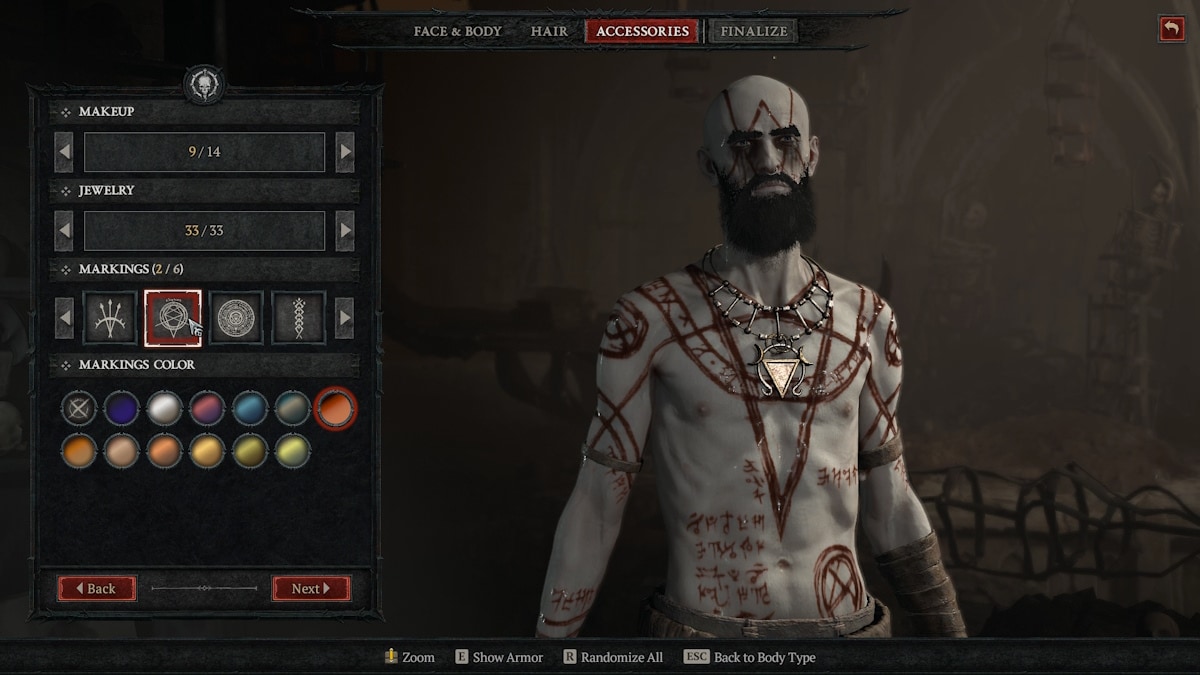Cards on the table: I’ve never played a plays a central figure in Diablo IV’s story. I couldn’t help but get all fanboy-ish as soon as I heard him — jittery on my chair with a stupid grin spread across my face, as I listened to his calming baritone. He’s also probably the only character whose dialogue I never skipped, which is saying a lot considering my issues with the narrative’s pacing.
Diablo IV review: Open-world, progression, and gameplay
Blizzard has certainly knocked it out of the park with an aesthetic that is gruesomely ugly. Piles of carcasses, severed limbs, pools of blood with rotting organs, bodies on crucifixes and spikes, some Lovecraftian tentacles wiggling about in some curdling brown goo — you name it — every step you take emanates with the stench of death. All of this is spread out across an atmospheric landscape that boasts demonic caves, lush forests teeming with deadly wildlife, putrid swamps, and snow-capped areas that howl with isolation. The world here is really massive, causing you to willingly or unwillingly absorb lots of it, especially in the early acts, where you can only travel on foot. Sure, there are mounts for fluid traversal, but the game doles it out much later.
Diablo 4 doesn’t really push the dungeon-crawling ARPG genre to new heights, but mixes borrowed ideas and the ones it pioneered through previous instalments to forge a worthy sequel. The gameplay loop largely revolves around an explore-kill-loot system, which while sounding bland, is actually quite addictive. Scattered around the world are points of interest, be it random spear-wielding minions, dungeons, and hostile wildlife — some of them being otherworldly werewolves, living trees, giant humanoid ovines, huge spiders, and the like.
While the combat pacing and style are initially determined by what class you picked, with progression, you pick up new skills that completely change your build. Up until level 50, you’ll often visit a web-like skill tree, whose paths branch out to unveil new perks that result in damage upgrades and an entirely new set of attacks.
As mentioned before, I mostly vibed with the Necromancer since my original plan was to simply whack away at enemies and flee when things got rough, hoping that my summoned undead would hold them back. However, with each new weapon and piece of armour I equipped, it wasn’t just the damage numbers but also my confidence levels that rose. I was no longer scared of overstaying my welcome in close proximity to an enemy, nor was I too stingy when glugging down my health potions.
Through skill level-ups, I was soon able to impale foes with bloody lances, unleash a concentrated blight that lingered, and even have laying corpses explode and inflict massive damage to surrounding enemies. With Corpse Tendril, I could perform some crowd control — activating it on a dead body bursts out tentacular veins that grab and pull enemies closer to it. By figuring out how various abilities synergise with each other, you could come up with your own custom build to persist in the brutality of Sanctuary. The possibilities are endless.
At Ubisoft Forward, Assassin’s Creed Mirage Promises a Return to Series’ Roots
The skill tree grants a new array of attacks, which can be personalised to your build
Photo Credit: Screenshot/ Rahul Chettiyar
In adopting the open-world format, Diablo IV also suffers from some enemy-scaling issues from around mid-game onwards. While certain regions do have a minimum level requirement, it will soon dynamically scale to match your level. For instance, if you’re scared to take on a level 30 mission with your level 20 character, you’d ideally go and explore the expansive world, taking detours and completing other missions, to eventually return overpowered. In this case, let’s say you come back as a level 35 character. However, the game will then adjust the said mission to be level 35 as well, raising the enemy stats and rendering the effort somewhat useless. I wasn’t really a fan of this, because it takes away from the immersion of being this lone warrior who defies all odds and progressively gets strong enough to steamroll through perilous monsters.
You do feel yourself getting stronger and more adept with Diablo IV’s combat system, sure, but there is definitely some restriction to it. Some permanent upgrades are woven into exploration by way of crafting healing potions and activating Altars of Lilith out in the wild, eerie statues that give an account-wide stat buff to your character. Furthermore, there’s the Paragon levelling system, aimed at late-game activities.
The board only unlocks once you hit level 50, with each of its nodes letting you massively buff your character build in small increments, over time. I’ll admit though, that the layout feels haphazard and quite intimidating to look at, and might take a while before you can fully wrap your head around it.
The inventory is quite exhausting, urging you to frequently replace equipment
Photo Credit: Screenshot/ Rahul Chettiyar
Inventory management is another core mechanic in Diablo 4, with the game limiting how much equipment you can carry. Running out of space can be a frequent occurrence, nudging you to open up the inventory and slot in better gear you find outside, while stockpiling the older, less powerful ones. While it can be annoying for some, I kind of relish this system since it pays off in the long run. The thing is, all equipment in the game, ranging from weapons, rings, amulets, and armour have durability points between 0 to 100 apiece, which drops by 10 units upon dying.
Once it gets to zero, the weapon breaks and becomes useless, which can be a common occurrence during boss fights, where you’re under the perpetual delusion that you’re going to get them the next time. So instead of hightailing back to the blacksmith to get it repaired, you can simply peek into the inventory and switch to hoarded gear that’s slightly less powerful.
Over time, the dungeon-crawling can feel a bit repetitive though, at least in terms of how the mob enemies behave. It won’t take too long for you to discern their attack patterns, as most of them simply chase after and surround you with pointy weapons. It’s not all blind hack-and-slash though, as the game occasionally tosses in horned red shamans who have a unique glow to them and keep summoning new enemies to make our journey annoyingly long. The AI is fairly smart and persistent as well and will chase after you if you move across rooms.
From a distance, combat will usually look unclear, like an unbridled mess of colours and lightning
Photo Credit: Screenshot/ Rahul Chettiyar
Others might stumble in with a large shield, or you might face bulky sword-slashing Revenants, or even Blood Mages that hurl projectiles from a distance. Fights rise in intensity really fast, advancing you on a path to defeat the dungeon’s boss, which at times can feel tedious and bland due to them being huge bullet sponges. Another gripe I have with Diablo IV is its side quests, which all feel like a bunch of checklists, where the NPCs ask you to go from point A to point B and bring back a specific item for them. On the way, you might have to slay some hordes or engage in lengthy dialogue with characters — monotonous activities — which I couldn’t help but skip through.
Diablo IV is a live service game through and through, with Blizzard aiming to support it for years to come with new seasons, battle pass, and expansions. The term has garnered some bad rep in recent times for its bad monetisation practices that otherwise warrant grindy gameplay, but here, the developers have assured that every purchase is merely cosmetic items.
Blizzard has promised that any microtransactions will simply be cosmetic
Photo Credit: Screenshot/ Rahul Chettiyar
Yes, there is an in-game shop that requires you to spend real-world money, but they’re not implemented in a way that you’d constantly get pinged or pushed into buying them. At the time of writing, it’s located in an entirely separate tab that isn’t bothersome to its players who paid AAA pricing for this game. I really hope it stays that way, though I have a theory that the only reason Diablo 4 even needs a constant internet connection to run, is so they could implement these microtransactions. Unless you plan on engaging in PvP battles or heading into co-op adventures with other players, I fail to see a reason why this game does not have an offline mode option. That said, I never faced any disconnection issues or noticeable latency, suggesting a strong foundation.
Diablo IV review: Verdict
If you’re in the mood to slay blood-lusting demons with an unhealthy dose of loot-clicking, Diablo IV is perfect for you. The sequel doesn’t reinvent the dungeon-crawling space in any way, but borrows ideas to offer intensely frenetic combat, robust progression, and totally knocks it out of the park with its dark, sacrilegious themes that turn its sprawling open world into literal hell. The tight enemy scaling is certainly a downside, but Blizzard evens it out with diverse classes that synergise uniquely with abilities, making encounters increasingly thrilling. The presence of microtransactions — albeit cosmetic-only — is a sour sight and the narrative would’ve surely improved with better pacing. Overall though, it’s devilishly addictive!


